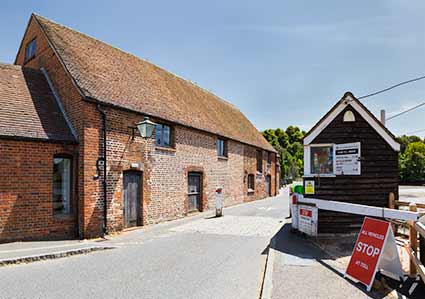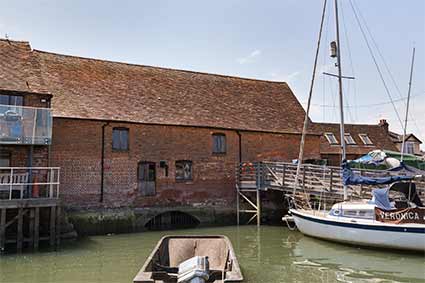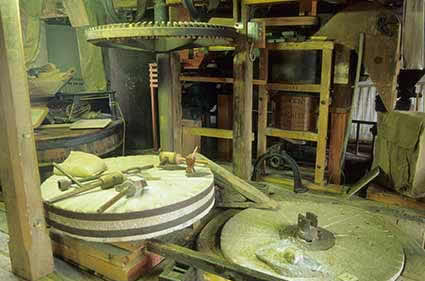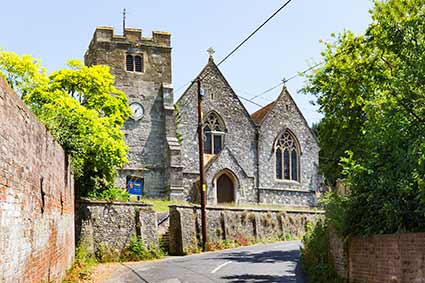Eling Tide Mill and Eling Parish Church


looking from the direction of Southampton Water


Eling Tide Mill
One of a small number of regularly working tide mills in the world, Eling Tide Mill harnesses the power of the tides to produce flour, which is available to buy in the mill shop.
The mill is situated on the edge of Southampton Water, not far from the New Forest. The location is said to be typical of tide mills the world over: on the seaward side of a causeway spanning an inlet (in this case Eling Creek, where Bartley Water reaches the sea) that branches off a tidal estuary - Southampton Water.
The earliest surviving mill lease dates back to 1418, although the Domesday survey of 1086 refers to two local corn mills, one or both of which might have been tide mills on this very site. The current Grade II* listed four storey building, however, is thought to have been constructed in 1785 by John Chandler, albeit on the base of an earlier mill; whilst the adjoining brick building, once the grain store and now used by Eling Sailing Club, is of early 19th century origin.
Two separate water wheels were used, each of which was independently connected to its own machinery. Power was therefore, in effect, provided for two mills within the same building.
Tolls have been collected for passage across the causeway since at least the 18th century. Milling continued until 1946, although the miller - Tom Mackrell - subsequently continued to collect the tolls, still at the 18th century rates, until his retirement in 1970. Today, tolls continue to be extracted from causeway users, now by New Forest District Council at substantially increased rates considered more appropriate to the 21st century.
Restoration of the mill, its equipment and associated structures commenced in early 1976 and culminated in the return of one water wheel and its equipment to 19th century working order, whilst the other wheel and equipment remains as a static display. The mill was officially opened to the public on May 1st, 1980 by TV newsreader and celebrity Angela Rippon.
More recently, following a £2 million facelift, the mill and associated facilities were re-opened in April 2018 by the Duke of Gloucester.
Visitor Centre
Across the road from the mill is the Visitor Centre, home to the Mill Café which offers a selection of speciality teas and coffees, homemade cakes and sandwiches - look out, in particular, for items made with Tide Mill flour! There is also a Discovery Room in the Visitor Centre, featuring interactive models and information about the mill and its history, and an Activity Room.
Eling Parish Church
Also nearby, across the causeway up Eling Hill, is Eling's historic parish church, a Grade II* listed building dedicated to St. Mary the Virgin. Of Saxon and Norman origin, the church was subject to substantial restoration by Benjamin Ferrey from 1863 to 1865, although reminders of earlier times remain, including the tower, which is mainly Tudor and Jacobean, and aspects of the interior such as 13th and 14th century arcading, the medieval nave roof, what has been described as a 'very fine and unusual 13th century chancel arch' and a small Norman window at the east end of the chancel. Also to be seen are a 16th century Venetian painting of the last supper and 18th century monuments by the important Flemish sculptor John Rysbrack.
A walk around Eling
Visitors might also wish to enjoy a stroll around Eling, starting at Eling Quay and taking in the Tide Mill, Eling Great Marsh, Goatee Beach, Eling Church, Bartley Reach and the mill's visitor centre and café; and to look out along the way for a range of wildlife including frequently abundant resident and migratory birds. (The route, mostly along footpaths and recently improved boardwalks, and on tarmac, is accessible for wheelchairs and pushchairs. There is a full description of the route here).
Eling Tide Mill - opening hours and parking arrangements
From April to September, the Tide Mill is open to the public every day from 10.00am - 5.00pm and in other months from Thursday to Sunday, 11.00am - 4.00pm, although milling is dependent upon, amongst other things, tide times. Car parking is available across the causeway, on the opposite side of the toll bridge, but toll payments will be refunded against admission charges to the mill.
Check here for further information.
References:
Eling Tide Mill - Diana Smith
Eling Tide Mill Experience brochure
New Forest National Park - New Forest Churches
British Listed Buildings - https://www.britishlistedbuildings.co.uk/101094344
-church-of-st-mary-totton-and-eling#.W1coX9VKjcs
More links
Search this site

Sadly, 58 animals were killed - 35 ponies, 13 cows, 8 donkeys and 2 sheep, whilst a further 32 were injured - 3 pigs, 9 donkeys, 11 cows and 9 ponies.
(Forty-three accidents occurred in daylight, 15 at twilight and 101 in the dark. Twenty-seven accidents were not reported by the driver involved).
Here's just one horrific example - Three donkeys killed in collision with van at notorious New Forest blackspot (Advertiser and Times)

